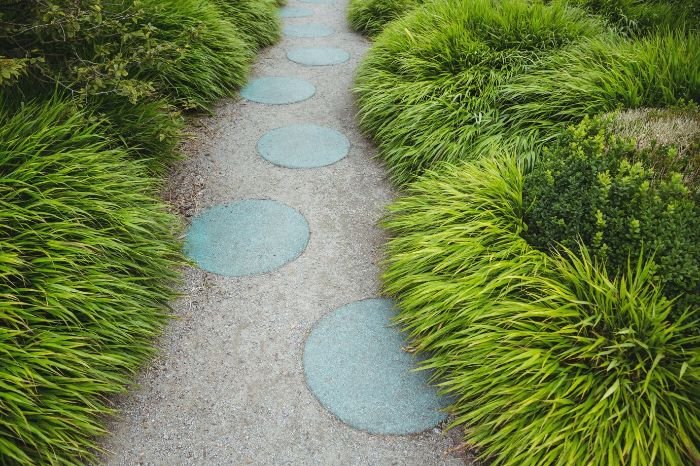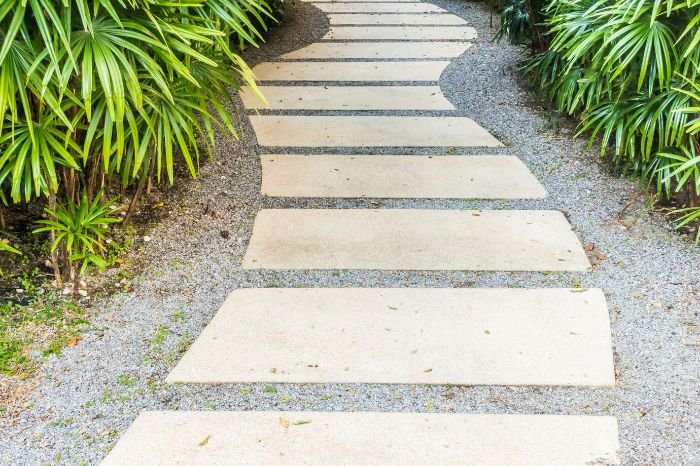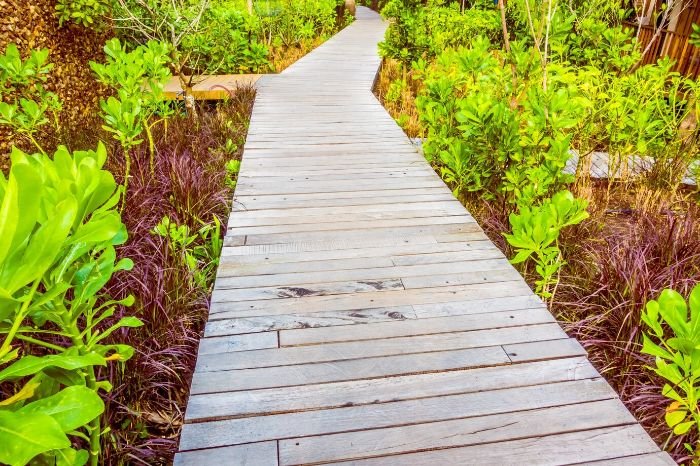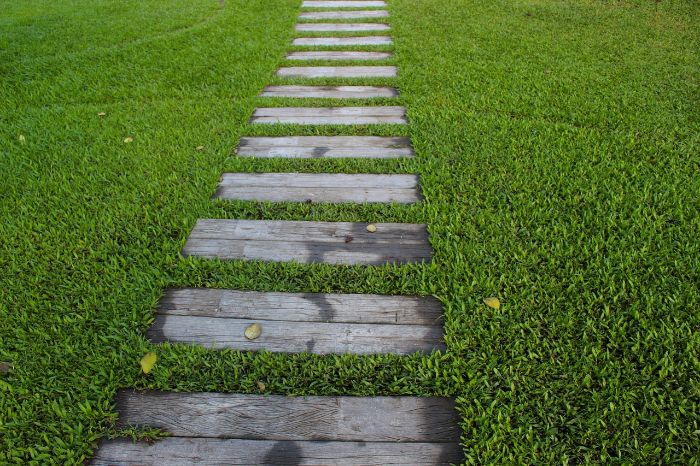Pathways influence how a garden functions and how it feels underfoot. The right surface must handle daily traffic, respond to climate, shed or absorb water, and match the design language of the site. Gravel and decomposed granite provide drainage and economy when contained by edging. Pavers, brick, and modular concrete deliver durable footing with repairable joints. Natural stone carries visual weight and decades of service if supported correctly. Wood and composites extend walkways over wet or root-filled zones where excavation is risky. Each material comes with its own maintenance cycle, cost profile, and design role.
Key Takeaways:
- Gravel and decomposed granite keep paths affordable and well-drained but need edging and periodic refresh.
- Pavers and brick give stable footing with joints that can be repaired one unit at a time.
- Natural stone adds weight and permanence when slabs are set on a solid, level base.
- Wood and composites span wet ground or root zones where excavation would cause damage.
- Climate, soil, and long-term upkeep determine which surface will endure in a garden, while price alone rarely predicts durability.
Table of Contents
Factors to Consider When Choosing Pathway Materials
Selecting the right material for a garden path depends on more than appearance. A surface must carry the weight of daily traffic, withstand weather shifts, shed or absorb water properly, and stay consistent with the broader landscape. Each choice interacts with soil, climate, and the maintenance level you are ready to commit to.
Traffic and Load
Paths that serve as primary routes (leading from house to patio or garage), face heavier wear. They need stable units such as pavers, brick, or stone set on a compacted base. Secondary paths used for lighter foot traffic can tolerate looser surfaces like gravel or decomposed granite. Service paths that see carts or bins need both strength and smoothness to prevent ruts. I have seen many gravel shortcuts fail in a single season when residents underestimated daily use.
Climate and Weather Resistance
Freeze–thaw cycles break apart porous surfaces if joints are not locked or bedding shifts. In northern climates, pavers with polymeric sand joints and dense natural stone handle expansion well. In hot, dry regions, gravel and decomposed granite resist heat and keep glare low. Wood can swell and decay in humid areas, so composites or treated lumber are safer in wet zones. Climate directly shapes longevity, so ignoring it leads to costly rebuilds.
Drainage and Soil Conditions
Clay soils trap water, so permeable assemblies with open-graded stone beneath pavers or gravel prevent pooling. On sandy soils, dense surfaces prevent washouts and hold grade. Sloped sites require materials that resist rolling and slipping – angular stone rather than pea gravel, or textured pavers instead of smooth units. Poor drainage beneath any path shortens its life, no matter how strong the surface looks above.
Maintenance Commitment
Every material comes with a maintenance pattern. Gravel needs raking and top-ups. Decomposed granite binds better but still requires occasional replenishment. Pavers demand joint refilling and weed control. Stone lasts longest when joints are tight and bedding is stable, but uneven units may need re-seating. Wood and composites need inspection for rot or fastener issues. Think in years, not weeks, when matching material to your maintenance habits.
Cost and Lifespan Balance
Initial cost does not always match long-term expense. Gravel is cheap at installation but needs yearly care. Pavers and stone are expensive to lay but can last decades with little intervention. Brick falls between the two, offering both character and durability when laid on a proper base. Wood can be affordable but often requires replacement sooner unless composite boards are chosen. Viewing cost over a 10-20 year span reveals the true value of a material.
Integration with Garden Design
Path materials tie together the hardscape and the planting. Stone or brick that matches house cladding creates cohesion. Gravel blends naturally with rustic beds, while sleek concrete pavers suit modern lines. Material tone affects plant perception – pale surfaces brighten shaded gardens, while darker stone grounds a sunny yard. A mismatched surface can break the visual flow even if it performs technically.
Quick Reference Guide
| Factor | What to Look For | Examples of Best Fit | Risks if Ignored |
|---|---|---|---|
| Traffic & Load | Stable footing, load-bearing | Pavers, brick, stone | Ruts, displaced gravel |
| Climate | Freeze resistance, heat tolerance | Dense stone, polymeric joints, gravel in arid regions | Frost heave, swelling, decay |
| Drainage & Soil | Permeability, slope stability | Open-graded stone bases, textured pavers | Puddling, erosion, instability |
| Maintenance | Frequency and ease | Gravel (rake), pavers (weed control), wood (inspection) | Higher cost over time, safety hazards |
| Cost vs Lifespan | Initial vs long-term expense | Stone, quality pavers | Frequent replacement, higher cumulative cost |
| Design Integration | Cohesion with house and garden | Matching tones, texture balance | Visual clash, disjointed layout |
Material selection is strongest when these factors are considered together rather than in isolation. Once the framework is clear, it becomes easier to evaluate specific material categories, for both durability and visual appeal.
Gravel and Decomposed Granite for Durable, Permeable Paths
Gravel and decomposed granite deliver strong drainage and low upfront cost. Performance depends on particle shape, gradation, base depth, and edge restraint. Correct spec prevents rolling stones, washouts, and ruts, while keeping lines crisp over seasons.
Material types and gradation that walk well
Angular crushed stone interlocks underfoot and supports carts. Chips in the 3/8-1/2 inch range give good traction for everyday use. Pea gravel uses rounded particles that feel pleasant but roll on grades and at turns. Decomposed granite contains very fine particles that bind into a firm, permeable surface, especially when blended with a stabilizer. Avoid mixed piles with wide size spread, which segregate under traffic and create soft pockets.

Base, depth, and edge control
Stable walking comes from a compacted base. Excavate organic soil, place a non-woven geotextile on clay or mixed fill, then add 3-4 inches of crushed stone base in two compacted lifts. Top with 2-3 inches of surface aggregate for gravel paths or about 2 inches of decomposed granite. Hold edges with powder-coated steel or aluminum set flush to finished grade. Along lawn, a brick soldier course or flush paver band creates a clean mowing strip and prevents turf invasion.
Slope limits and climate performance
Gentle slopes keep loose aggregates in place. Reserve pea gravel for flat runs. Use angular chips on modest grades and widen curves to limit scuffing. In freeze-thaw regions, a free-draining base prevents frost heave. In deep shade, algae can slick smooth stones; angular chips or decomposed granite provide better grip. Near downspouts or concentrated runoff, redirect water or switch to a permeable paver assembly that stores and meters flow.
Maintenance pattern and lifecycle cost
Gravel paths need periodic raking to pull displaced stones back into the walking line. Expect a light top-up every year or two depending on traffic. Decomposed granite compacts more tightly; a stabilizer reduces dust and extends intervals between refreshes. Weed seeds germinate in windblown fines, so edge sweeping and spot treatment keep joints clean. Over a decade, material cost remains low, with most expense in occasional replenishment rather than structural repair.
When gravel excels and when to choose another surface
Gravel suits informal gardens, utility runs, and budget builds where wheelbarrow traffic is moderate and edging is acceptable. Decomposed granite performs well around raised beds and seating courts that need permeability without puddles. For wheelchair access, heavy cart routes, or steep approaches to doors, pavers or stone give firmer footing and easier snow removal. Locations with heavy leaf drop also favor dense surfaces that sweep cleanly.
Quick gravel spec guide
| Option | Surface aggregate | Base depth (compacted) | Slope guidance | Edge restraint | Typical upkeep |
|---|---|---|---|---|---|
| Angular gravel path | 3/8-1/2 in crushed chips | 3-4 in crushed stone | Best on gentle grades; widen curves | Steel/aluminum or brick band | Rake after storms; top-up annually or biannually |
| Pea gravel path | 3/8 in rounded pea gravel | 3-4 in crushed stone | Flat runs only; avoid turns and slopes | Steel/aluminum | Frequent raking; displacement common |
| Decomposed granite (DG) | DG with or without stabilizer | 3-4 in crushed stone | Handles mild grades; good traction | Steel/aluminum | Light regrading; add DG as needed; less rolling |
Gravel and decomposed granite reward precise specification. With the right gradation, base, and edging, a permeable path stays tidy and comfortable.
Pavers, Brick, and Modular Concrete for Stable Footing
Modular units give firm, repairable surfaces that handle daily traffic and snow shovels without rutting. Performance depends on a compacted base, a true 1-inch bedding layer, tight joints, and solid edge restraint. Choose a standard dense assembly for easy sweeping or a permeable assembly where drainage next to beds matters most.
Assembly that carries weight
Start with a uniform subgrade. Strip organic soil, correct grade for a 1-5% fall, and place a non-woven geotextile on clay or mixed fill. Build a base of crushed stone in compacted lifts: 4-6 inches for walkways that see carts and regular use. Screed a consistent 1-inch bedding layer of coarse sand. Set units to string lines, cut edges cleanly, and install edge restraint before final compaction. Sweep polymeric sand into joints in freeze-thaw regions, then compact the surface to seat units and lock the field.
Permeable pavers when drainage drives the choice
Permeable systems move rain through the surface into an open-graded base. Use 8-12 inches of clean stone for storage, a 1-2 inch choker layer of smaller clean stone, and pavers with spacer tabs. Fill joints with No. 8 or similar clean aggregate. Provide an overflow route to a swale or dry well so extreme storms do not pond. Maintenance focuses on keeping joints free of fines; a blower or hard-scape vacuum every season preserves infiltration.
Brick paths that age gracefully
Fired-clay brick brings color and a classic read along lawns and terraces. Dry-set assemblies follow the paver spec: 4-6 inches of compacted base and a 1-inch sand bed. Running bond reads calm along straight axes, while herringbone locks best at turns. Bricks vary in dimension more than concrete pavers, so check courses often to prevent drift. Where salts or sprinklers leave marks, a gentle acid wash or cleaner labeled for clay can remove efflorescence without scarring the face.
Edge restraint and patterns that resist drift
Unbraced edges let units spread under traffic. Spike-in paver edging works for most walks; cast-in-place curbs control high-use borders. Keep restraint flush with the finished grade so brooms and mower wheels do not catch. Patterns affect shear resistance. Herringbone at 45° or 90° locks well at drive and cart turns. Stretcher courses along edges frame fields cleanly and ease cutting.
Accessibility and safety details that matter
Smooth, even planes reduce trips and make wheel use practical. Keep joint openings under 3/8 inch and limit vertical lippage to 1/8 inch where possible. Texture improves grip in shade and when wet. Hold cross-slope near 1-2% so water moves off the surface without creating a lean. At door thresholds, maintain a slight step or install a narrow trench drain to avoid splashback.
Quick spec guide for modular surfaces
Surface type Base (compacted) Bedding layer Joint material Edge restraint Slope guidance Typical upkeep Concrete pavers (standard) 4-6 in crushed stone 1 in coarse sand Polymeric sand Spike-in paver edging or curb 1-5% fall, 1-2% cross-slope Refill joints as needed; reset any rockers Permeable pavers 8-12 in clean, open-graded stone 1-2 in small clean stone Clean No. 8 aggregate Paver edging or curb 1-5% fall with overflow route Seasonal vacuum/blow to keep voids open Brick (dry-set) 4-6 in crushed stone 1 in sand Polymeric sand for tight joints Brick or paver edging 1-5% fall, 1-2% cross-slope Spot joint repair; monitor for efflorescence A well-built modular path delivers stable footing and clean lines for decades. If the site calls for a more natural look with stronger visual mass, large-format stone slabs and flagging become the next material family to evaluate.
Natural Stone and Slabs for Timeless Walkways
Stone brings weight, texture, and a long service life. Performance depends on consistent thickness, full bearing on the bedding layer, and joints that manage water. Choose format and assembly based on slope, climate, and the level of maintenance you accept.

Formats and thickness that stay stable
Irregular flagstone reads organic and suits informal gardens. Dimensional stone with sawn edges reads orderly and speeds installation. Large formats reduce joints but demand a flatter subgrade. Aim for 1½-2 inches thickness for pedestrian paths. Thin veneers chip at corners and rock underfoot. Inspect pallets for thickness tolerance; wide variation slows laying and creates lippage. I specify natural-cleft or thermal finishes in shade-prone runs because those textures keep grip when wet.
Dry-set versus mortared assemblies
Dry-set stone rides on a compacted base with a free-draining bedding layer. Use 4-6 inches of crushed stone base and 1-2 inches of stone dust or fine gravel that locks slabs. Joints can take polymeric sand on tight dimensional work or fine clean gravel on wider joints to keep permeability. Mortared stone sits over a concrete slab on a bond coat. That choice holds best on steep slopes and at door thresholds. Include control joints in the slab and weeps at edges so trapped water does not frost-jack the surface.
Joints, drainage, and freeze-thaw resilience
Joints do more than close gaps. Tight joints filled with polymeric sand limit weeds and shed debris. Open joints filled with clean chips let rainfall enter and store briefly in an open-graded base. Hold the path to a 1-5 percent fall with 1-2 percent cross-slope so water never lingers over stone faces. In cold regions, avoid saturated bedding by keeping fines to a level that still drains; frost heave starts where water stays trapped. Sealers change surface behavior; breathable penetrating sealers protect against stains with less slip risk than film-forming coatings.
Traction, edges, and cutting quality
Wet leaves and shaded runs expose slick finishes. Natural-cleft, flamed, or bush-hammered textures retain traction. Eased or chamfered edges resist spalling at corners. Keep joints under ⅜ inch on dimensional units to maintain smooth wheel travel. Where paths meet turf, set stone slightly above lawn grade and notch the grass edge for runoff. Use a low curb, steel edging, or a brick band to confine bedding and keep lines clean.
Maintenance and lifespan expectations
Stone ages well when joints stay intact and bedding stays dry. Sweep leaves to avoid tannin stains. Treat iron stains with products labeled for natural stone. Re-seat any rocking slabs by lifting and rebuilding the bedding to level. Avoid de-icing salts on limestone and sandstone; use sand for winter traction. A periodic low-pressure wash restores color without lifting joint material.
Quick guide to common pathway stones
| Stone | Best context | Typical finish | Strengths | Watch-outs |
|---|---|---|---|---|
| Bluestone / sandstone | Temperate climates, formal or informal | Natural-cleft or thermal | Flat laying surfaces, strong visual unity | Some varieties absorb; seal in leaf-heavy sites |
| Granite | High wear, freeze-thaw zones | Flamed or bush-hammered | Very dense, top slip resistance | Hard to cut; higher tool cost |
| Slate (dense varieties) | Mild to cool, low acid rain | Natural-cleft | Rich color, good grip | Layered structure can delaminate if soft or highly porous |
| Limestone (dense grades) | Mild winters, classic gardens | Honed or textured | Calm tone, easy shaping | Sensitive to salts and acids; choose dense stock |
| Travertine (exterior-rated) | Warm, dry climates | Tumbled | Cool underfoot, elegant read | Void structure varies; avoid in harsh freeze-thaw |
A stone path adds authority to the layout when format, bedding, and joints all serve drainage and traction.
Wood, Composite, and Alternatives for Sites That Stay Wet or Root-Bound
Deck-style walkways solve problems that rigid surfaces cannot. Timber or composite boards span soft ground, bridge surface roots, and install with minimal excavation. Proper framing, ventilation, and slip control keep footing secure and extend service life.
Where decking outperforms masonry
Sites that hold water after rain, narrow passages with utilities, and tree lines with shallow roots benefit from a light structure that sits above grade. A decked path avoids deep digging that would smother roots or pump mud into a base. Elevated surfaces also break contact with saturated soil, which reduces algae growth on the walking plane.
Framing, spans, and footing choices
Structure dictates durability. Use ground-contact rated posts and framing where lumber meets soil. Helical anchors or small concrete piers carry loads without wide excavation. Keep 4-6 inches of air space under boards for ventilation; more airflow improves drying. Typical spans: joists at 12-16 inches on center for composite boards, 16 inches for 5/4 treated wood, and 12 inches where heavy wheel loads pass.
Deck boards need gaps of 1/8-1/4 inch to drain and to shed debris. Cap joists with flashing tape in wet climates to slow rot at screw lines. A geotextile with a thin gravel layer under the walkway suppresses weeds and stops splashback.

Board materials – wood vs composite
Treated southern pine offers low initial cost and easy cutting. Cedar and redwood resist decay better, though periodic sealing preserves color and slows checking. Composites and recycled-plastic boards remove annual sealing from the maintenance list and hold shape on curves with heat-forming systems. Wood stays cooler under bare feet in full sun; composites resist splinters and warping when installed over rigid framing. Use stainless or polymer-coated fasteners to prevent stains, and consider hidden clip systems for a flush walking surface.
Traction, edges, and transitions
Grip matters in shade. Grooved or brushed textures shed water and improve footing on dew-prone mornings. Keep the board crown up so water sheds instead of pooling. Edge treatment shapes how the path reads against planting. A slim rim board holds a clean line; a low curb guides wheels on narrow runs. At door thresholds or patio joins, introduce a short ramp or a narrow trench drain so water never backs against sills. Where the deck meets lawn, hold the walking surface slightly proud and notch turf for a clear exit path for runoff.
Maintenance patterns you can predict
Algae blooms where shade and irrigation overlap. Wash surfaces with a deck cleaner that targets biofilm and rinse at low pressure. Recoat wood every two to three seasons in wet regions; spot-sand checks before they collect water. composites benefit from a spring scrub and inspection of clip tension. Replace any board that cups or traps puddles, since standing water accelerates decay in surrounding members.
When to choose alternatives to boards
Mulch paths, resin-bound gravel, and stepping stones set into compacted fines each solve narrow problems. Mulch reads natural in woodland beds and installs quickly, though it needs edging and replenishment and can float during storms. Resin-bound gravel creates a seamless, permeable surface with fewer loose stones than traditional gravel, but demands careful base prep and edging. Large stepping stones over a granular bed create stable footing through planting while keeping the visual field green between units.
Quick spec guide for decked and alternative paths
| Surface type | Structure/Base | Traction & drainage | Maintenance profile | Best use case |
|---|---|---|---|---|
| Treated wood boards | Posts/piers, joists 16″ OC | Brushed finish, 1/8-1/4″ gaps | Seal every 2-3 yrs; replace damaged boards | Shaded or wet routes with modest spans |
| Composite boards | Posts/piers, joists 12-16″ OC | Factory texture, clip systems | Annual wash; check clips | Low-maintenance garden spines and curves |
| Mulch path | Geotextile + 2-3″ mulch | Drains freely, needs edging | Top-up seasonally | Woodland beds, informal runs |
| Resin-bound gravel | Compacted open-graded base | Permeable, smooth | Occasional sweep; patch repairs | Clean look without loose stones |
| Stepping stones in fines | 3-4″ compacted base + fines | Stable pads with green infill | Spot relevel; trim groundcover | Natural look through planting zones |
A light, ventilated structure or a carefully chosen alternative keeps movement reliable where soil or roots push back. If lighting will guide evening travel along these routes, integrate shielded fixtures into rim boards or low posts so glare stays off the walking plane.
Conclusion – Pathways Built to Last
The right material choice balances function, climate, and care. Focus first on surfaces that stay stable under traffic and drain correctly on your soil. Then refine by texture, tone, and upkeep so the path fits seamlessly into the garden. When structure and detail align with context, a pathway not only performs reliably but also matures gracefully with the landscape.
FAQ
What is the best material for garden pathways?
Match material to use and site. Interlocking pavers give stable footing, clean joints, and simple spot repairs. Natural stone adds long service life when slabs sit fully supported on a flat bed. Gravel and decomposed granite lower upfront cost and drain well on gentle grades when restrained by edging. Boardwalk-style paths in wood or composite span wet ground and protect tree roots where excavation would harm them.
What is the cheapest material for a garden path?
Angular gravel is usually the lowest-cost durable choice. Build it over 3-4 inches of compacted crushed-stone base and add 2-3 inches of ⅜-½ inch chips, with steel or aluminum edging to stop creep. For ultra-low budgets in woodland beds, shredded bark over geotextile works, but it needs frequent top-ups and can float during heavy rain.
What is the best material for a sloping path?
Textured pavers or dimensional stone perform reliably on slopes because units interlock and resist rolling. Hold a 1-5% fall in the walking direction and keep cross-slope near 1-2% for drainage. Decomposed granite with a stabilizer can handle mild grades, while pea gravel should be avoided because rounded stones slide and rut.
How thick should a garden path be?
Depth depends on the assembly. Gravel paths need a 3-4 inch compacted base plus 2-3 inches of surface aggregate. Pavers or dry-set stone call for a 4-6 inch compacted base and a true 1-inch bedding layer. Permeable pavers that store stormwater often require 8-12 inches of open-graded stone based on rainfall and soil infiltration. Strip organic soil before building to achieve uniform support.
What rock works best for a pathway?
Angular crushed stone provides traction and interlocks underfoot. Use ¾-inch minus for base layers and ⅜-½ inch chips for the walking surface. Decomposed granite creates a firm, permeable top when compacted, especially with a stabilizer. Pea gravel reads pleasant but performs poorly on slopes or tight turns because rounded particles roll.
What is the cheapest way to edge a garden path?
Steel or aluminum edging offers a low profile, clean line, and moderate cost, which makes it cost-effective for gravel and decomposed granite. Along lawn, a single brick soldier course or a flush paver band doubles as a mowing strip and reduces trimming labor. Timber can be inexpensive up front but tends to warp or decay in wet soil, which raises long-term cost.








